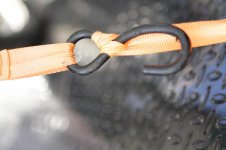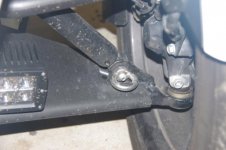FWIW: some thoughts on trailering... and use of tie-downs
FWIW, I do some extensive trailering of my Spyder... over 4000/5000 miles each year. Mostly, this is the round trip from Ontario to Florida and back, plus a few other short hauls. Sometimes, it's trailering one of my boats, or a utility trailer job. I have hauled canoes across the continent on car rooftops; same issues apply.
I try to approach the task of fastening any load, not just from the perspective of "tie-ing it down" securely, but then stepping back, seriously looking at how I have done it, and asking myself: "what can go wrong?"; "what happens next if it does?"; "can things come apart?" "can I lessen the likely damage?" Am I guilty of over-thinking things? Maybe; but it could help prevent an expensive law suit, should an unwanted accident occur. Life has a habit of throwing us a curve ball when we least expect it. A trailering accident can easily expand to involve other drivers and nasty results played out in hospitals or courtrooms. It's not just a simple matter of loading, hauling, unloading, ryding. It's also a matter of what happens if it all comes apart.
So, it's not just what and how we tie down; it's whether we did it the best way, followed good advice, didn't take short-cuts, used good sense and the best equipment. Mike (BlueKnight911) uses a system favored by many leading haulers of priceless autos. Can't go too far wrong there. BRP advises straps through the wheel rims. Again, following instructions in your Spyder manual will certainly stand you in good stead should something occur that necessitates later warranty claims, or gets challenged in a law suit alleging that you were negligent. Of course, this means using good quality straps whatever your method. Cheap, sub-standard straps will likely lead to grief.
I'm very wary of putting heavy tie-down force on any part of the Spyder's steering arms or front shocks. While this might hold a Spyder in place for short and uneventful travel, in the case of a sudden, sharp stop at Interstate speed, a quick evasive maneuver or collision, the extreme inertial force created by the Spyder trying to break free of the trailer and launch itself into space will likely do more than just upset your alignment, and will be bad enough if it does only that!!
I, personally, use the "through the rims" method for all 3 wheels, independently. That's 3 quality straps of sufficient load-bearing capacity. Then, I go into 'overkill' mode; I use two more. This is where the earlier, above-mentioned "what can go wrong?" and "how can I prevent it?" analysis comes in. Straps can break; they can wear through from friction caused by road vibration at high-speed travel. I use an additional ratchet strap at the front. This is, I admit, placed around the 'A arms' and through my trailer frame (different place entirely from where front rims are tied), but loosely done up so as to place no pressure/force on the Spyder. It's only there to prevent the 'ultimate catastrophic separation' of Spyder and trailer from taking place, if necessary. It's a bit of defensive strategy, hopefully never needed, and requiring only a couple more minutes out of a 24-hour journey. Same for the rear. I place another extra ratchet strap through the Spyder's trailer hitch, loosely anchored at each side of the trailer's rear. The main rear tie down strap goes through the rim (avoiding the sprocket) to its own anchors on the rear frame.
In all, I have 5 attachment points/straps. Too many? Perhaps. But better to spend a few extra minutes over-securing my load than a few lost hours picking up bits of scrap metal and Spyder plastic along a highway, then talking to investigating police officers and/or explaining to a judge.
One last bit of advice: the job is not finished when you tie down your Spyder and are ready to jump in your vehicle and head down the road. Before you do that, make sure your trailer hitch coupling is tight, has a safety clip, and that your safety chains are secure. Do a 'circle check' and ensure that your running lights, brake lights and turn signals all function properly. Nothing is worse than coming up on an unlit trailer at night on a dark road, or one whose signal lights have failed because the lines are worn and shorted, or the plug has fallen out, or simply was left unconnected. If the driver behind you can't figure out your driving intentions, your Spyder and trailer might just become the 'crumple zone'. Check your tire pressures, all around. After you've started off and driven for 20 minutes, pull over and re-check you tie-downs for snugness. Loads have a tendency to shift, and straps will loosen. Check all straps early and often. Circle check at every pit stop. It takes but a minute or two, but could save you a lifetime of agony.
Now, having given my sermon, have I ever had problems? ever had anything happen? Hell, yes!! I've had straps wear through and break - friction!!! I've had straps mysteriously become undone mid-journey; ever so glad I used that extra, 'overkill' back-up. I've had tires spring slow leaks. Even had both trailer tires begin to suffer tread separation last year while doing Interstate speeds. The memory of that still shakes me; I had looked both tires over before starting, but not closely enough; their life expectancy obviously was less than I had thought. So much can go wrong in spite of best efforts. I have to keep reminding myself to "take the time", do it right and double check. Also, grease your trailer axle bearings regularly; beats being stranded miles from nowhere with a wheel seized up unable to roll.
Get your load there safely and in one piece. Trailer right, ryde safe, have fun!!


